The report of the Secretary of War for the year ending June 30, 1897, shows the strength of the regular army of the United States at that time to have been 27,532 officers and men. It has never been the policy of the United States to maintain a large standing army, as do many of the nations of Europe. On a peace footing Germany's standing army numbers 585,440, Russia's 863,672, France's 644,564, Italy's 231,355, Austria-Hungary's 358,697, Turkey's 700,620, Spain's 128,183, Japan's 284,741, and Great Britain's 222,870.
While it is not considered necessary that the regular army of the United States should be increased to anything like these figures, the present war and its evident results make it manifest that the size of our regular army, which has heretofore been too small, will hereafter be entirely inadequate, and that the time has been reached in our national growth when the army should be definitely increased to a size proportionate with our vast population and increased responsibilities.
Since the last report of the Secretary of War there have been added to the service two regiments of artillery, so that the army as now organized consists of ten regiments of cavalry, seven regiments of artillery, twenty-five regiments of infantry, an engineering battalion, and a signal corps, so that the army as now organized contains over 29,000 officers and men on a peace footing.
On account of the present war the regular army has been organized on a war footing in conformity with a bill passed by Congress April 23, 1898, and with all arms of the service recruited up to their full strength in conformity with the provisions of this bill the twenty-five infantry regiments contain 32,885, the artillery 16,886, cavalry 12,447 officers and men, and with the increase in the engineering and signal corps the grand total of officers and men on the present war footing is 64,985. At the end of the war the army will be reduced to a peace basis by transfer in the same arm of the service, absorption, promotion or honorable discharge, under such regulations as the Secretary of war may establish. There will result no permanent increase of the regular army beyond that provided by the law in force prior to the present war, except an increase of twenty-five majors in the infantry arm.
Beside the regular army we rely for protection upon the National Guard and the volunteers. The National Guard is composed exclusively of state troops under the command of the governors of the respective States, and is largely the result of the policy of this country of maintaining a small standing army. The latest reports received at the office of the Adjutant-General, show the total number in the National Guard of the various States and Territories to have been 115,627 in 1896, and the number now is somewhat greater.
Congress makes an appropriation each year for the support of the National Guard in the various States, and the States also accord help and build armories in order that the troops may be well drilled. By this means theyfurnish a high order of volunteers in time of war.
The volunteers, which form a branch of the service only to be found in war, are such as offer their services upon the call of the President. In the recent call for volunteers it was the President's wish that the National Guard or State militia should be used as far as their number would permit, because they were organized, equipped and drilled. The National Guard responded promptly, and most of the regiments were mustered into the service. On April 23d the President issued a proclamation calling for 125,000 volunteers. After the battle of Manilla and the bombardment of San Juan de Porto Rico, a second call was made by the President for 75,000 additional volunteers. The officers of the National Guard, below the rank of Brigadier-General, were in nearly every case retained. The higher officers were appointed by the President and were taken from West Point graduates, the State militia, or civil life. Some of the regiments of volunteers were of a special character, such as Roosevelt's "Rough Riders" and the "Astor Battery."
The following are the sub-divisions of the army on a war footing as provided by the new army bill passed April 23, 1898:
A company is an infantry organization consisting of 106 enlisted men, one second lieutenant, one first lieutenant and commanded by a captain.
A troop is the corresponding cavalry organization and consists of 100 enlisted men, one second lieutenant, one first lieutenant and a captain.
A battery is the corresponding artillery organization and consists of 173 enlisted men in the light artillery, 200 men in the heavy artillery, one second lieutenant, one first lieutenant, and commanded by a captain. The President is empowered to add an extra second lieutenant to each battery of artillery.
A battalion consists of four companies, troops or batteries and is commanded by a major.
A regiment, which is the administrative unit, is composed of twelve companies, troops, or batteries, one lieutenant-colonel, and is commanded by a colonel.
A brigade consists of three or more regiments commanded by a brigadier-general and sometimes by a colonel.
A division consists of three brigades, and there may be an independent brigade of cavalry or artillery, and is commanded by a major-general or a brigadier-general.
A corps is the largest tactical unit of a large army, fully organized with separate staff, infantry, cavalry, and artillery regiments, as well as auxiliary services, so that it is really a small army complete in itself and is usually composed of three divisions. It is commanded by a major-general.
An army is divided into two or more corps and is commanded by a major-general.
Logically the army should be commanded by a general, each corps by a lieutenant-general, a division by a major-general, and each brigade by a brigadier-general. This would necessitate, however, a large increase in the salary of officers, and the Congress of the United States has not seen fit to put it into operation.
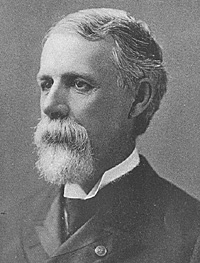 The commander-in-chief of the army is, of course, ex officio,
the President of the United States. The Secretary of War is the
Hon. Russell A. Alger (at right), and the Assistant Secretary of War the
Hon. George D. Meiklejohn. The following are the departmental
officers with the rank of brigadier-general: Adjutant-General,
Samuel Breck; Inspector-General, Jos. J. Breckenridge;
Quartermaster-General, G. H. Weeks; Commissary-General, Wm.
H. Bell; Surgeon-General, Geo. M. Sternberg; PaymasterGeneral,
Thaddeus H. Stanton; Chief of Engineers, John M. Wilson; Chief
of Ordnance, Daniel W. Flagler; Judge Advocate General, G. N.
Lieber; Chief Signal Officer, A. W. Greeley; and with the rank of
colonel, Chief Record and Pension Officer, F. C. Ainsworth.
The commander-in-chief of the army is, of course, ex officio,
the President of the United States. The Secretary of War is the
Hon. Russell A. Alger (at right), and the Assistant Secretary of War the
Hon. George D. Meiklejohn. The following are the departmental
officers with the rank of brigadier-general: Adjutant-General,
Samuel Breck; Inspector-General, Jos. J. Breckenridge;
Quartermaster-General, G. H. Weeks; Commissary-General, Wm.
H. Bell; Surgeon-General, Geo. M. Sternberg; PaymasterGeneral,
Thaddeus H. Stanton; Chief of Engineers, John M. Wilson; Chief
of Ordnance, Daniel W. Flagler; Judge Advocate General, G. N.
Lieber; Chief Signal Officer, A. W. Greeley; and with the rank of
colonel, Chief Record and Pension Officer, F. C. Ainsworth.
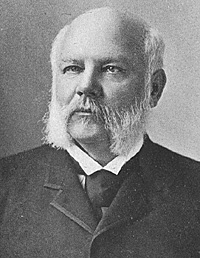 The pay of the officers in active service is as follows:
Lieutenant-General, $11,000; major-general, $7,500; brigadier-general, $5,500; colonel, $3,500; lieutenantcolonel, $3,000; major,
$2,500; captain (mounted), $2,000; captain (on foot), $1,500;
regimental adjutant, $ 1,800; regimental-quartermaster, $ 1,500;
first lieutenant (mounted), $1,600; first lieutenant (on foot), $1,500;
second lieutenant (mounted), $1,500; second lieutenant (on foot), $1,400.
The pay of the officers in active service is as follows:
Lieutenant-General, $11,000; major-general, $7,500; brigadier-general, $5,500; colonel, $3,500; lieutenantcolonel, $3,000; major,
$2,500; captain (mounted), $2,000; captain (on foot), $1,500;
regimental adjutant, $ 1,800; regimental-quartermaster, $ 1,500;
first lieutenant (mounted), $1,600; first lieutenant (on foot), $1,500;
second lieutenant (mounted), $1,500; second lieutenant (on foot), $1,400.
Gen. John M. Schofield
These amounts are increased ten per cent after five years' service, twenty per cent after ten years' service, thirty per cent after fifteen years' service, and forty per cent after twenty years' service; but the maximum pay of a colonel is limited to $4,500, and of a lieutenant-colonel to $4,000. The pay of a private in any arm of the service is $13 per month for the first and second years, $14 for the third year, $15 for the fourth year, $16 for the fifth year. After five years' continuous service he receives $2 per month extra. During this war twenty per cent is added to the pay of all enlisted men, but not to that of the officers.
Military Schools
The United States has but one military academy, which is located at West Point, N. Y., and military instruction under the direction of lieutenants of the regular army, detached for that service, is given in about one hundred colleges throughout the United States. The West Point cadets come from the various States and Territories of the Union, each Congressional district and Territory being entitled to one cadet in the academy, the nomination being made by the representative. This nomination is usually made after a competitive examination, but may be given directly.
There are also ten other appointments which are usually conferred upon the sons of officers of the army and navy by the President of the United States. Therefore, the number of students is limited to 371. Foreign governments may, however, have cadets educated at the academy by authorization of Congress. The course of instruction requires four years and is largely mathematical and professional. The appointees must be between the ages of 17 and 22 years, of sound health, and free from any infirmity which may render them unfit for military service. The discipline is very strict, even more so than in the army. During his stay at West Point, each cadet receives $540 per year, and after graduation he is commissioned a second lieutenant in the United States army. On account of the rigid requirements a large proportion of the cadets fall by the wayside each year. The number in attendance September 1, 1897, was 338. The school can accommodate a much larger number, and it has been proposed to add two cadets from each State, one to be appointed by each United States senator.
The number of students who received military instruction at the 100 colleges throughout the country was 15,608 in 1896.
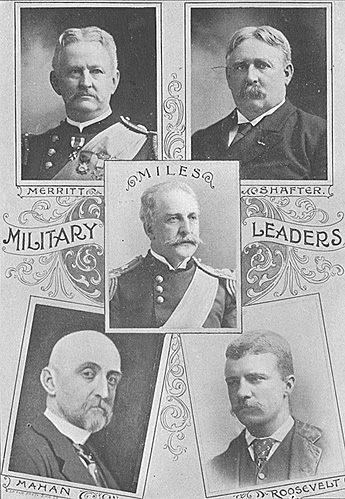 Nelson A. Miles
Nelson A. Miles
Major-General in command of the army, was born at Westminster, Mass., August 8, 1839. His ancestors settled in Massachusetts colony in 1643. He was reared on a farm and in early manhood engaged in mercantile pursuits in Boston. Early in 1861 he raised a company of volunteers and offered his services to his country. He was given the commission of a captain, but being considered too young for the responsibilities of that command he joined the Army of the Potomac as first lieutenant in the 22d Massachusetts volunteers. In 1862 he was commissioned by Gov. Morgan of New York as lieutenant-colonel and colonel of the 61st New York volunteers.
At the earnest request of Gens. Meade and Grant he was made a brigadier-general of volunteers by President Lincoln. He was perhaps engaged in more hard-fought battles than any general officer of our army, including 35 distinct battles and over 100 serious affairs in which artillery, cavalry and infantry were engaged. He commanded regiments, brigades and divisions, and at one time, February, 1865, was in command of the second army corps, which numbered at that time over 25,000 men, and which is believed to be the largest command ever handled by an officer in this country at 25 years of age. In the latter part of the war his command was the first division, second army corps, the largest of all the divisions.
General Miles was wounded at the battles of Fair Oaks, Fredericksburg and Chancellorsville, and received four brevets for gallantry and distinguished service. At the close of the war he commanded the district of North Carolina during the work of reconstruction, and on the reorganization of the army he was appointed colonel of infantry. He was made a brigadier-general, U.S.A., in 1880 and a major-general in 1890. He has successfully conducted Indian campaigns in all parts of our great West, and has on several occasions prevented Indian wars by judicious and humane settlement of the difficulties without the use of military power.
Major-General John R. Brooke
was born in Pennsylvania July 21, 1838, and was a farmer boy of 23 when he responded to the first call of President Lincoln for troops in 1861. He participated with credit in nearly all of the battles of the Army of the Potomac, rising from captain to brigadier-general of volunteers, receiving two brevets for distinguished services. Since the war he has been on duty in the West, in command of the department of the Platte and of the department of the Missouri.
"When he fights he wins" is the reputation he has acquired among those who have served under him.
Major-General Wm. R. Shafter
came from what Lincoln called the "plain people." He entered the 17th Michigan Infantry as first lieutenant in 1861 at the age of 25. He served with distinction through the war and was twice brevetted for gallant and meritorious service. Since the war he has served with distinction in the Indian campaigns as colonel of the 24th Infantry, and as brigadier-general in command of the department of the Pacific. General Shafter weighs over 300 pounds, is gruff, sturdy and warm-hearted. He has been criticised for his conduct of the campaign against Santiago, but his best reply to this criticism is found in the completeness of his victory. He has won such honors as came to Grant, and escaped the humiliations of less energetic and venturesome leaders.
Major-General Wesley Merritt
was born in New York city in 1836, graduated from West Point in 1860, and during the Civil War rapidly rose to the rank of majorgeneral of volunteers. He received six brevets for gallant and meritorious service. In 1866 he was appointed colonel of the 9th Cavalry, and later for several years managed the Military Academy at West Point. Since then he has worked himself up from grade to grade in the Indian campaigns, and many military men, especially West Pointers, regard him as the greatest genius of the army.
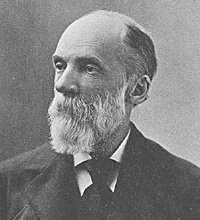 Major-General Joseph Wheeler
Major-General Joseph Wheeler
(at right) graduated at West Point in 1859 and entered the Confederate army at the start of the civil war. He was rapidly promoted, serving as lieutenant of artillery, colonel of infantry, brigadier-general, major-general, and lieutenant-general of cavalry.
In 1864 he received the brevet of general of the Confederate army. After the war he became a lawyer and planter in Alabama and for the past dozen years has been a representative in Congress.
As a cavalry officer Gen. Wheeler ranked with Sheridan. Audacious, fearless, aggressive, energetic, and an excellent strategist, his campaigns throughout the civil war were marked by dash and valor. He captured Gen. Prentiss' division at Shiloh, covered the retreat from Shiloh to Corinth and Perrysville, winning the highest commendation from Confederate generals; turned Rosencrans' flank at Murfreesboro and distinguished himself at Chickamauga, Missionary Ridge and in the struggle from Chattanooga to Atlanta. He was wounded three times and had sixteen horses shot under him. An indefatigable student and worker, and as a legislator handles public questions in a masterly way.
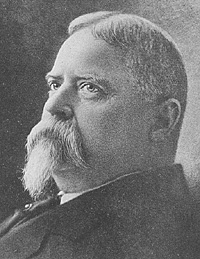 Major-General Fitzhugh Lee
Major-General Fitzhugh Lee
(at right) was born in Virginia in 1835, graduated from West Point in 1856, and was returned there as instructor of cavalry in 1860, where he continued until the beginning of the civil war. He entered the Confederate army as first lieutenant of cavalry and rapidly rose to major- general. Was severely wounded at Winchester after three horses had been shot under him. After the war he retired to his farm in Stafford county, Va., for several years, and was elected Governor of Virginia in 1885 for a term of four years. In 1896, he was appointed by President Cleveland to be consul-general at Havana, where he remained until the breaking out of the present war.
Major-General James H. Wilson
graduated from West Point in 1860, just in time to win his major-general's double star within three years of his graduation. He was one of the greatest cavalry leaders produced by the Union side during the Civil War. He is most famous for his dashing cavalry raid into Alabama and Louisiana in 1865. The consummate skill and brilliant success with which he handled 12,000 troopers in this campaign proved the wisdom of General Grant in selecting him for this important command.
At this time General Wilson was about twenty-seven years of age, and the men who swung into their saddles at the sound of his bugle to follow his battle-flag were mostly youngsters from twenty to twenty-five years of age, though all seasoned veterans of three or more years' service. General Wilson retired from the army in December, 1870, and has since been engaged successfully in railroad management in the United States and China.
Colonel Theodore Roosevelt
was born in New York City, October 27, 1858, his father's people having lived in that city for eight generations. He is quick, intense, nervous, incessant, and an actor in, not a spectator of, the drama of the times. Sickly as a boy, his first active work was in making himself a physically able fellow. He graduated from Harvard in 1880. He believes "that in a free republic like ours, it is a man's duty to know how to bear arms and to be willing to do so when the occasion arises," and he evidenced his belief by joining the Eighth Regiment of the New York State Nat'l Guard in 1884, rising to be captain of one of its companies.
In 1884 he started his cattle ranch in the Bad Lands of Dakota, where he spent several summers. In the New York State Convention of 1884 he first became conspicuous and was sent to the National Convention at Chicago. He was sent to the New York Legislature for three successive terms in 1883, 1884 and 1885. After General Harrison's election as President, he appointed Roosevelt as Civil Service Commissioner, and that post he held until he became a police commissioner in 1895. From this position he was appointed Assistant Secretary of the Navy under the present Administration, and at the breaking out of the present war resigned to go to the front as lieutenant-colonel of Roosevelt's "Rough Riders."
Next: Chapter 13: The Future of America
Back to The Passing of Spain Table of Contents
Back to Spanish-American War Book List
Back to ME-Books Master Library Desk
Back to MagWeb Master Magazine List
© Copyright 2005 by Coalition Web, Inc.
This article appears in ME-Books (MagWeb.com Military E-Books) on the Internet World Wide Web.
Articles from military history and related magazines are available at http://www.magweb.com